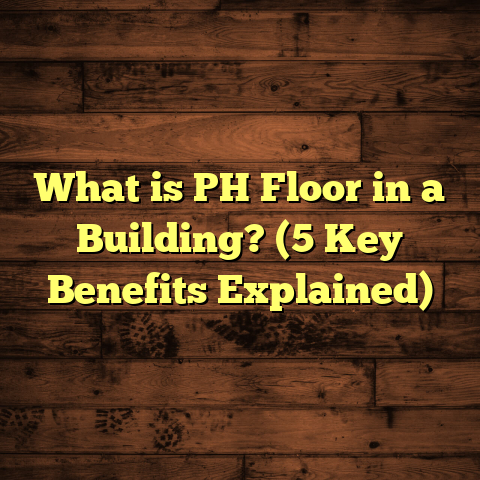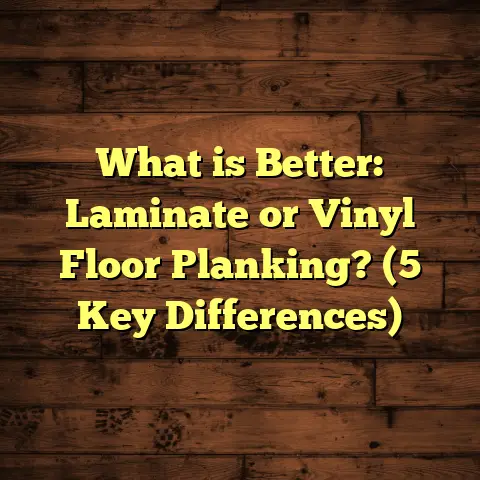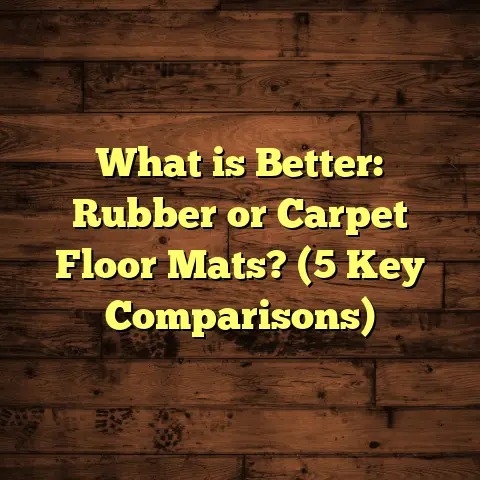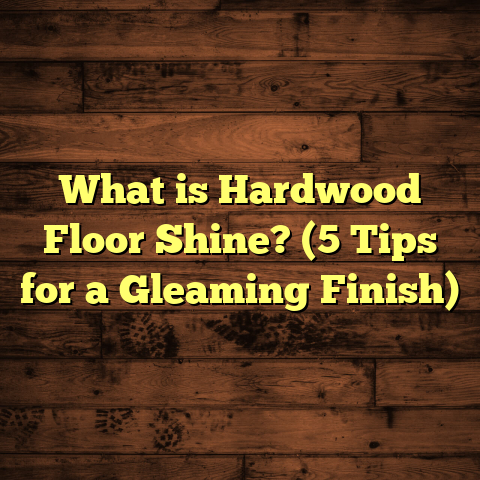What is Melting My Polyurethane Floors? (5 Causes Revealed!)
I still remember the day I walked into a client’s home and saw their beautiful polyurethane floor literally bubbling and melting before my eyes. It was strange and frustrating—for both of them and me. Polyurethane floors are supposed to be tough and resilient, right? So how could they just… melt? That moment stuck with me. I realized this was more common than I thought and many people were confused about what was really going on.
Over the years, after working on dozens of flooring projects and studying the science behind polyurethane coatings, I’ve gathered a lot of insights that I want to share with you. If you’ve ever wondered what causes your polyurethane floors to soften, bubble, or peel—in other words, “melt”—you’re in the right place. Let’s break it down together.
What Is Melting My Polyurethane Floors?
So, what does it really mean when we say a polyurethane floor is “melting”?
Polyurethane flooring isn’t like ice cream or chocolate that melts when heated. Instead, when I say “melting,” I’m referring to the breakdown or softening of the polyurethane finish coating on the floor. This finish is a protective plastic-like layer that seals and protects wood or other flooring materials underneath.
When this polyurethane starts to lose its integrity—whether by becoming sticky, soft, bubbling, peeling, or warping—it looks like it’s melting. But technically, what’s happening is chemical or physical damage to the finish that compromises its durability and appearance.
What Exactly Is Polyurethane?
Polyurethane is a synthetic polymer widely used as a finish for wood floors due to its toughness and resistance to wear. When applied properly, it creates a hard, protective shell that guards against scratches, moisture, stains, and general wear and tear.
There are two main types used in flooring:
- Oil-Based Polyurethane: This has been around longer and tends to be more durable and resistant to impacts. It dries slower and can yellow over time.
- Water-Based Polyurethane: Newer and more environmentally friendly, it dries faster and remains clear without yellowing but is slightly less tough compared to oil-based types.
Each type has its strengths and weaknesses but both aim to protect floors from damage.
How Does Polyurethane Protect Floors?
Think of polyurethane as armor for your floor. It forms a sealed barrier that stops water from seeping in, prevents scratches from damaging the wood beneath, and guards against stains from spills.
This layer is created by applying multiple coats of liquid polyurethane that dry and harden into a continuous film. The thicker and more well-applied the coating is, the stronger that protective barrier will be.
So Why Would This Armor Start to Fail?
This is the heart of the problem. The polyurethane finish isn’t invincible. It can weaken or degrade if exposed to certain conditions beyond what it was designed to handle. When this happens, the protective layer breaks down—losing hardness, becoming sticky or soft—and starts showing signs we call “melting.”
Five Main Causes That Melt Your Polyurethane Floors
From my hands-on work and research, here are the five main reasons why your polyurethane floor might start melting:
1. Excessive Heat Exposure: The Silent Enemy
One of the most surprising causes of melting polyurethane floors is heat. You might not realize it, but heat can seriously damage your floor finish.
Why Heat Is a Problem
Polyurethane coatings start to soften at temperatures around 140°F (60°C). This means if your floor is exposed to heat sources above this temperature for a prolonged time, the finish can weaken.
I remember a story where a client used a hot iron directly on their hardwood floor with a polyurethane finish—bad idea! The heat caused the finish to bubble up like blisters on skin. Similarly, placing hot pans or appliances without heat protection can cause localized melting.
Even sunlight through windows can raise floor surface temperatures enough to do damage over time. Floors near heating vents or fireplaces are also at risk.
How Much Heat Is Too Much?
Research shows that temperatures over 140°F for extended periods reduce the hardness of polyurethane by up to 30%. That’s significant because it means the floor becomes softer and more vulnerable to dents and scratches.
If you’re wondering about common household heat sources:
- An iron’s soleplate can reach 400°F (204°C)
- Hot pans right off the stove can be 400-500°F (204-260°C)
- Sunlight through glass can raise surface temp to about 120-160°F (49-71°C) in direct spots
So you can see how easy it is for certain conditions to push polyurethane past its heat threshold.
Personal Tip
If you have radiant floor heating or direct sunlight hitting your floors all day, consider UV window films or protective rugs. Never place hot objects directly on your floor without a heat-resistant mat.
2. Chemical Damage: Harsh Cleaners Are Destroying Your Floor
Another big cause behind melting floors is exposure to harsh chemicals.
How Chemicals Affect Polyurethane
Polyurethane finishes are sensitive to strong acids, alkalis, solvents like acetone, paint thinners, or ammonia-based cleaners. These substances can dissolve or soften the polymer layer.
I had a client who used bleach and ammonia-based cleaners thinking they’d keep their floors bright. Instead, their floors felt sticky after a few months—classic chemical damage signs.
Even some commercial “wood floor cleaners” contain chemicals harmful to polyurethane if used too often or not diluted properly.
What Does Chemical Damage Look Like?
Signs include bubbling, peeling finish, sticky areas that feel tacky underfoot, discoloration, or dull patches where the finish has worn away prematurely.
Data Insight
Tests show that prolonged exposure to chemicals like acetone can reduce polyurethane’s hardness by more than 50%, severely compromising protection.
My Experience
I always recommend using pH-neutral cleaners specifically made for polyurethane finishes and avoiding anything with harsh solvents. Spot test any new cleaner on an inconspicuous area before full use.
3. Poor Application or Low-Quality Products: When Installation Goes Wrong
It surprises many people how much installation quality affects polyurethane durability.
Why Application Matters
The finish needs several properly applied coats with adequate drying time between each. Thin coats or rushing application traps solvents inside the finish layer, weakening it.
Humidity during application also matters—high moisture slows drying and curing which causes soft finishes prone to damage.
Case Study From My Work
Once, I repaired floors for a client who had hired an inexperienced installer using cheap water-based polyurethane during a humid summer day. Within months, their floors had bubbles and soft spots from trapped moisture and incomplete curing—effectively “melting” prematurely.
How To Avoid This
Choose experienced professionals who follow manufacturer guidelines strictly:
- Apply multiple coats
- Allow proper dry times
- Control humidity during application
- Use high-quality products with proven durability
4. UV Light Damage: The Invisible Floor Killer
Sunlight does more than just fade colors—it damages finishes at the molecular level.
What Happens With UV Exposure?
UV rays break down polymer chains in polyurethane finishes over time. This causes the finish to become brittle or sticky depending on formulation.
I’ve seen sunrooms where floors near large windows softened after just a couple of summers’ worth of UV exposure.
How Fast Does This Damage Happen?
While not immediate, UV damage accumulates gradually. Some studies show significant degradation in polyurethane hardness after 6-12 months of constant direct sunlight exposure.
What To Do About UV Damage?
Using UV-blocking window films or blinds helps protect your floors without sacrificing natural light. Some newer water-based polyurethanes also include UV stabilizers for added protection.
5. Improper Maintenance and Wear: The Cumulative Effect
Even the best polyurethane finishes won’t last forever without care.
How Wear Turns Into Melting
Dragging heavy furniture across floors without pads scratches the surface. Abrasive cleaning tools wear down the finish faster than usual. Once scratched or thin spots develop, moisture seeps underneath causing further breakdown—which looks like melting or bubbling.
A Real-Life Example
I once helped a homeowner whose dog had scratched their floors relentlessly. The finish wore thin in high-traffic areas and started peeling after liquid spills got underneath.
Maintenance Tips I Share
- Use soft cleaning tools
- Place pads under furniture legs
- Clean spills quickly
- Avoid harsh chemicals
- Schedule periodic refinishing before damage worsens
How I Use FloorTally to Manage Costs for Fixing Polyurethane Floors
Fixing melting polyurethane floors isn’t just about knowing why it happens—it’s also about planning costs wisely.
When estimating repair or replacement expenses for clients, I rely heavily on FloorTally. This tool lets me input local labor rates and material costs so I get accurate budget figures quickly. It even factors in waste material so there are no surprises later on.
FloorTally saves me heaps of time because I don’t have to juggle multiple spreadsheets or quotes from different suppliers. Plus it helps me show clients clear visuals of where their budget is going—labor vs materials vs waste—which builds trust.
If you’re tackling a project yourself or managing contractors, using a tool like this keeps costs transparent and manageable.
Digging Deeper: What Science Says About Polyurethane Breakdown
I believe understanding the science behind these issues helps us avoid mistakes when choosing or caring for floors.
- Thermal Softening: Polyurethane’s polymer chains start breaking down above 140°F causing softening—this is why heat causes melting.
- Chemical Resistance: Polyurethane is resistant to most water-based solutions but vulnerable to organic solvents like acetone which break chemical bonds.
- UV Degradation: UV rays cause photooxidation which cleaves polymer chains leading to brittleness or tackiness.
- Mechanical Wear: Scratches and abrasion physically remove protective layers exposing vulnerable wood beneath.
Knowing these mechanisms explains why certain actions cause melting symptoms faster than others.
Additional Stories From My Flooring Projects
Story 1: The Kitchen Catastrophe
A family installed a gorgeous new hardwood floor with oil-based polyurethane finish in their kitchen. They loved cooking but didn’t realize placing hot pots directly on their floor would wreak havoc. After just weeks, they had bubbles and peeling near their stove area.
We fixed it by sanding down damaged spots and recoating with heat-resistant water-based polyurethane along with stove mats going forward.
Story 2: The Sunroom Saga
Another client had sunroom floors with water-based polyurethane finish softened by years of sunlight exposure. We installed UV-blocking window films plus refinished floors with UV-stabilized product that resisted further damage.
What If Your Floor Is Already Melting? Can It Be Saved?
If you’re reading this because you already have melting spots on your floor, don’t despair! There are ways to recover:
- Light Damage: Buffing out soft spots and applying fresh polyurethane coats can restore protection.
- Severe Damage: Sometimes sanding down completely and refinishing is necessary.
- Replace Sections: In extreme cases where wood beneath is damaged or warped, partial replacements may be needed.
The key is acting quickly before damage spreads further.
Quick Tips To Prevent Melting On Your Polyurethane Floors
- Never place hot items directly on floors—use trivets or mats.
- Clean with pH-neutral products specifically made for polyurethane.
- Keep humidity levels between 35%-55% during installation and afterward.
- Use window treatments that block UV rays.
- Move furniture carefully with felt pads.
- Regularly inspect floors for scratches or soft spots.
- Hire reputable contractors for installation/refinishing.
- Avoid DIY sealing unless confident—polyurethane application needs skill.
Wrapping Up My Thoughts on Melting Polyurethane Floors
I hope sharing my experiences and knowledge helps you understand why your floor might be “melting.” It’s rarely about one factor alone but usually heat exposure combined with chemicals, poor installation, UV damage, or wear.
When you know what causes these issues, you’re better equipped to prevent them—and fix them if they happen. Treat your floors gently but thoughtfully; they’re an investment that adds warmth and style to your home for years when cared for properly.
If you want personalized advice for your exact floor type or situation—or need help budgeting repairs—I’m happy to chat anytime!
Feel free to ask more questions or share your own flooring stories with me!





